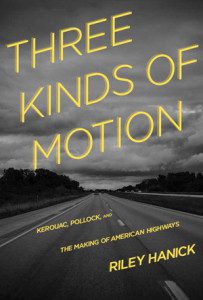
In his book-length lyric essay Three Kinds of Motion, Riley Hanick connects three nodes of American postwar history: Jack Kerouac and the Beat Generation, Jackson Pollock and Abstract Expressionism, and Dwight Eisenhower and the construction of the national highway system. At the confluence of these three nodes is Iowa, the place where Peggy Guggenheim once gifted Jackson Pollock’s painting Mural to the University of Iowa Art Museum. Iowa is also the place where Hanick once glimpsed the scroll on which Kerouac first mad-typed his famous paean to rambling, On the Road, and where he himself came of age, reading the beat poet and painting houses in the summers. (Full disclosure: I met the author when he came to Iowa City for a reading.)
“1956,” Hanick writes, “In a year the book will be bound, published as a modest stack. On June twenty-ninth, the National Highway Act is passed. Ike is all smiles all day. On August eleventh, after a few years of almost no painting at all, Jackson crashes his Oldsmobile into two small elms, a quarter-mile from his house on Fireplace Road.”
In tracing these overlapping histories, Hanick enters into a sort of spiritual union with Kerouac and Pollock—the Jacks—as he excavates what could be called the American soul. Kerouac and Pollock serve as his ghostly doubles, containers for Hanick’s own ruminations on abstraction, movement, time, and stasis. Hanick incorporates old correspondences and quotes into the text, creating a polyvocal chorus that merges the personal with the historical, like a mild schizophrenia. Owing a debt to the prose poem, Three Kinds of Motion is at once lyric, mournful, and slyly humorous. It does nothing to mitigate the strangeness of history, those voices of the past that echo in the present.
“Movement has been [America’s] dominant fact,” wrote Frederick Turner in his famous nineteenth-century treatise on the ever-expanding frontier. It is this dream of open space, this will towards speed and flight, this mysterious élan, that Hanick breaks open in his debut work. It’s “a stampede… [of] every animal in the American West, cows and horses and antelopes and buffaloes. Everything is charging across that goddamn surface,” Pollock once said about his Mural. But in Hanick’s hands history is not a heedless forward march through time; instead it is fractal, repetitious, simultaneous—as complex a constellation as the system of highways that crosshatches the country, as maddening as Pollock’s dizzying eddies, as replete with longing as Kerouac’s luckless drifters. In a sense, this is the anti-Manifest Destiny, the emptying out of the frontier dream, the deconstruction of one of our country’s grandest narratives.

Indeed, the book, less a stampede than a circle dance, subverts any readerly attempt at linear progression. The movement is centrifugal. Each fragment of text, each isolated scrap, contributes to a feeling of rising and falling intensities. The story culminates in the epic flood that ravaged Iowa City and its museum in 2008. (The Pollock, thankfully, was saved.) But the end, to quote T.S. Eliot, “Will be to arrive where we started / And know the place for the first time.” In the course of a few pages, the narrative might leap from 2008 to 1936, knotting together the decades:
A strange calm covers the town I come back to and I am out of sync with it, seeking each day another view of the river, wanting to see how it has arranged itself, what it has done, how it splays at a different angle with every cross street […] Jack found himself a little hilltop and stood on it for a view of the floodwaters after the Merrimack washed away his father’s printshop in 1936 and later says he had an epiphany of sorts. Something about the world eating or cleaning itself, destroying its own evil. I would look it up, but prefer instead my own stupidity and insights, which amount to rephrasing this sense of being lodged in the town of my birth, unable to finish a manuscript. The universe repeats itself without end, and stays in place, pawing the ground, or so it got copied down.
In the postwar period, Pollock’s anarchic action paintings celebrated the performative and spontaneous. They were a rebellious visual rebuttal to the demands of representational painting. And what Pollock did for painting, Kerouac might have done for literature—unchaining the art form from convention, foregoing premeditation to loose the free-flowing unconscious. This sense of freedom and abandon, Hanick suggests, is also embodied in the highway, an infrastructure that invites escape. Spontaneity, he writes, is a “minor rapture of being animated stuff” and “the wish for perpetual departure.” At the same time, we have to confront how quickly this feeling of vitality evaporates, how unending escape can be just another form of emptiness: “[Pollock’s] act was tantamount to everything remaining so open or possible or still to be done it was absolutely nothing.”
Writing about a moment of political, technological, and cultural transformation, Hanick shows how a new experience of time and space emerged in the mid-twentieth century. And yet he is also after something else—some essential life force or desire. “why am I alive?” he quotes Kerouac, writing in the twilight hours.
The book revolves around motion, but it’s also a meditation on stillness. Although legend has it that Mural was finished in a single night, Hanick points out that later studies reveal “there had been plenty of waiting.” And as Hanick knows—he details his lonely tenure as a security guard in a parking garage, watching the cars slow and break—every movement contains the seed of its own inevitable stop. Within every painting is a core of silence that is beyond the reach of words. Within each departure is a small death.




